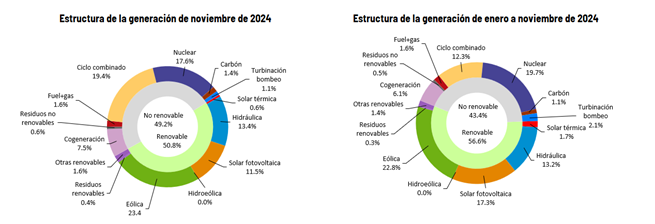National electricity demand in November fell by 0.4% compared to the same month of the previous year, once the effects of temperature and work are discounted. In gross terms, a demand of 19,724 GWh is estimated, 1.3% less than that of November 2023.
In the first eleven months of 2024, Spain has recorded a cumulative demand of 225,532 GWh, 0.7% more than in the same period of 2023. Once the effects of work and temperatures are taken into account, demand grows by 1.4% compared to the same period of the previous year.
This November, renewables generated 10,460 GWh and reached a share of 50.8% of the total, while 69.1% of the electrical energy was produced without emitting equivalent CO2.
The first source of production for the month was wind power, with a share of 23.4%, followed by combined cycle (19.4%), nuclear (17.6%) and hydraulic power, responsible for 13.4% of the total. For its part, solar photovoltaic energy grew by 17.1% in November and recorded a share in the mix of 11.5%.
Renewables, which closed November with a contribution of 137,785 GWh in all of 2024, already exceeded their entire production in 2023. Likewise, wind power recorded its highest figure in terms of daily generation on November 21, recording 434 GWh, more than half of the Spanish generation on that day.
Peninsular demand in November
At the peninsular level and once the effects of working hours and temperature have been taken into account, demand has been 0.6% less than in November 2023. In gross terms, demand for this month has been 18,556 GWh, 1.6% lower than that of the same month of the previous year.

In the cumulative period from January to November of this year, peninsular demand has been 211,534 GWh, 0.8% higher than that recorded in 2023. Once the effects of working hours and temperatures have been taken into account, peninsular demand has grown by 1.4% compared to the same period of the previous year.
The set of peninsular renewables generated 10,352 GWh this November, with which it achieved a share of 53.1% of the total peninsular production structure. For its part, emission-free technologies contributed 72.5% of the total.
The peninsular generation structure in November is also led by wind power, which has been responsible for 24.5% of the total, followed by nuclear power with 18.6%, combined cycle power with 17.2% and hydropower, responsible for 14.2% of the total.
The electrical system in the Balearic Islands and the Canary Islands
In the Balearic Islands, electricity demand in November was 3.5% higher than in the same month of 2023, once the effects of working hours and temperatures have been taken into account. Thus, gross demand is estimated at 386,949 MWh, 3.6% higher than in November of the previous year. From January to November 2024, gross demand in the Balearic Islands is estimated at 5,577,683 MWh, 0.1% less than in the same period in 2023.
In terms of generation, the combined cycle, with 75.1% of the energy produced in the Balearic Islands, was the main source of energy for the islands this month. For its part, renewable energy generated in the Balearic community represented 12.5% ??of the total. Renewable production in the Balearic Islands grew by 6.4% in November compared to the same month of the previous year.
In addition, during this month of November, the submarine link between the Peninsula and Mallorca contributed to covering 20.2% of the Balearic electricity demand.
For its part, in the Canary Islands, the demand for electricity increased by 2.3% compared to the same month in 2023, taking into account the effects of work and temperatures. In gross terms, demand was 748,211 MWh, 2.3% more. In the first eleven months of 2024, the Canary Islands’ demand is estimated at 8,058,567 MWh, 0.5% more than in the same period of 2023.
As for electricity generation in the Canary Islands, the combined cycle, with 54.7% of the total, was also the main source in November. Renewables reached a share of 9.2% of production by generating 68,852 MWh. For its part, the wind energy contribution during this month was 5.8% of the total.